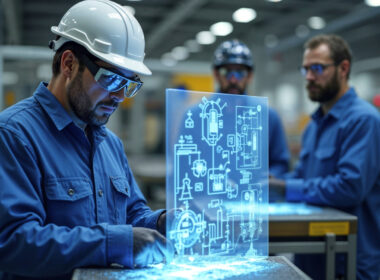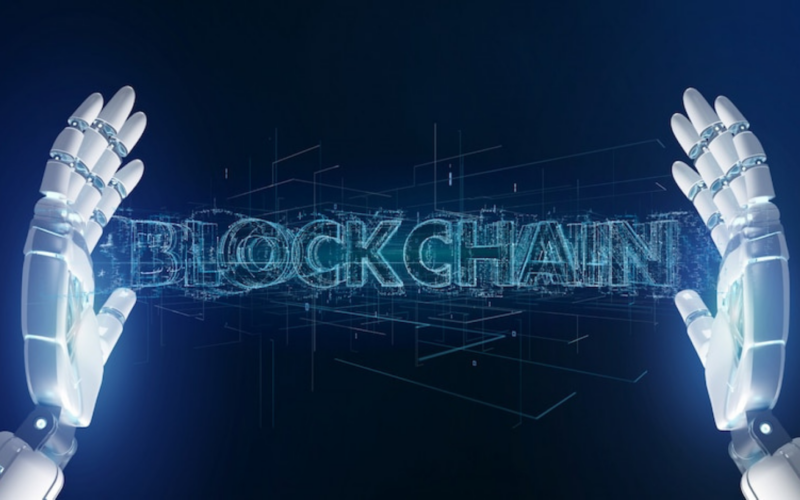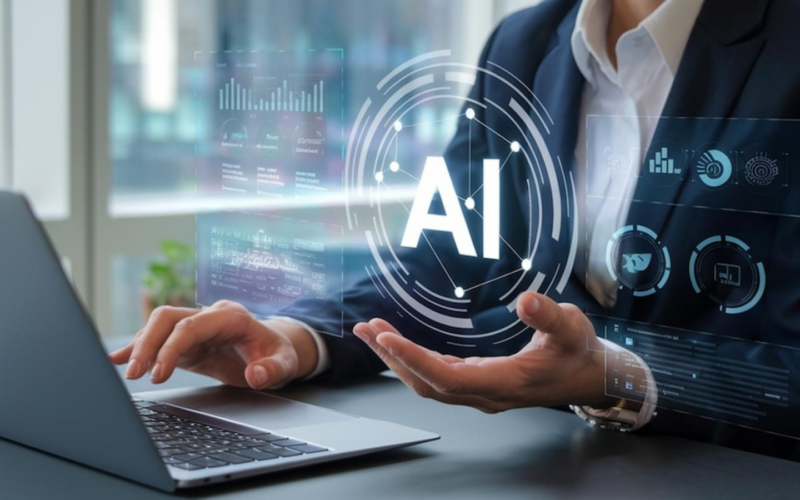AI on the blockchain is revolutionizing industries by combining artificial intelligence’s ability to learn and adapt with blockchain’s secure, decentralized nature. For example, IBM’s Food Trust Network uses AI to analyze supply chain data on the blockchain, ensuring transparency and preventing fraud.
With 164 decentralized AI companies worldwide, 104 of which have secured funding, the sector has raised $12.8 billion in the past decade.
As your business explores AI integration with blockchain, you may encounter challenges related to scalability and security that need careful attention.
This article shows how AI on the blockchain improves security and efficiency, with examples that highlight how you can benefit from this combination.
- AI on Blockchain: Enhances security, transparency, and scalability in decentralized applications.
- Key AI Models: Federated learning, decentralized neural networks, and reinforcement learning are ideal for blockchain integration.
- Data Privacy & Integrity: Blockchain ensures secure, tamper-proof data handling for AI-driven systems.
- Codewave’s Expertise: We help businesses integrate AI with blockchain to build efficient, scalable, and secure solutions.
AI on the Blockchain: Key Concepts and Architecture
Suppose you’re a business managing sensitive customer data. Every time you update or share this data, you’re dealing with the risk of breaches or errors. Now, think about how AI on the blockchain can change that.
With blockchain’s secure, decentralized nature and AI’s ability to analyze vast amounts of data, This synergy brings much-needed transparency and reliability, especially when privacy is a top concern.
Let’s look at how key concepts function within blockchain’s technical framework.
1. Decentralized Data Storage for AI Models
Let’s say you’re managing customer data. Instead of storing everything in one central database that’s vulnerable to a single point of failure, blockchain keeps copies across multiple locations.
If one node gets attacked, the others still have the data intact. This enhances the security of your AI models by protecting the training data and outcomes.
2. Smart Contracts for AI Automation
You’re using AI to predict inventory levels and you want an automatic restocking order to be placed when stock is low. A smart contract can automatically trigger the order when the AI model signals it’s time. No human intervention, no delay.
This kind of automation streamlines processes and reduces errors.
3. Blockchain’s Role in Securing AI Model Integrity
In scenarios where accuracy is critical, like in healthcare AI, blockchain guarantees that the model’s training data hasn’t been tampered with. You can trace back every decision the AI makes, giving you confidence that your model is working on reliable, unaltered data.
4. Consensus Mechanisms for AI Validation
In your AI projects, especially those involving multiple stakeholders, consensus mechanisms ensure that any decisions made by AI models, such as approving a loan or detecting fraud, are agreed upon by all parties before being executed.
This maintains fairness and trust across the system, avoiding potential bias or errors.
5. Tokenization of AI Models
Tokenization in blockchain refers to creating digital tokens that represent assets or data. These tokens can be used for transactions, rewards, or access rights.
For instance, you could tokenize the value of a machine learning model’s prediction and allow others to pay for access to it. It opens up new ways to monetize AI models and incentivize collaboration.
6. Interoperability and AI Model Sharing
Interoperability allows different AI models and platforms to work together, sharing data and insights across networks.
Blockchain facilitates this by providing a secure and standardized way for different AI systems to communicate and share data, ensuring that models trained on different platforms can collaborate without compromising security.
Facing challenges with securing and streamlining your business operations? Explore Codewave’s Blockchain Implementation services, where we create secure, transparent, and decentralized solutions tailored to your needs. Let’s optimize your business today!
Next, let’s look at how AI models actually work on the blockchain and what that means for your projects.
AI Models on the Blockchain
Suppose you’re running an AI-powered fraud detection system for financial transactions. Traditional systems rely on a central database, but that means they’re vulnerable to hacks or data breaches.
With AI on the blockchain, the model can run across multiple decentralized nodes, ensuring that data is secure and transactions are verified without relying on a single point of control.
Below are the AI models that work well with blockchain:
1. Federated Learning
Federated learning is a decentralized approach to training AI models, where multiple devices or servers collaborate on model training without sharing raw data. Instead, only model updates are sent to a central server, ensuring data privacy and security.
When paired with AI on the blockchain, federated learning can securely manage updates across a distributed network while maintaining transparency.
How it works:
- Each device (or node) trains the AI model locally on its own data.
- The trained model updates are then sent to a central server, or in the case of blockchain, to a decentralized network for aggregation.
- Blockchain records and verifies the updates, ensuring authenticity and transparency in the process.
Ideal For: Applications requiring data privacy, such as healthcare, finance, or mobile devices, where data cannot be centralized or shared directly.
Pros and Cons:
| Pros | Cons |
| Data remains on local devices, ensuring privacy. | Model aggregation can be slow. |
| Easily scalable by adding more devices without centralizing data. | Relies on computational power of individual devices, which may vary. |
| Blockchain ensures secure, tamper-proof updates. | Blockchain introduces network overhead, potentially affecting performance. |
| Blockchain provides an immutable record of model updates. | Setting up federated learning on blockchain can be complex. |
| Fault-tolerant: other devices continue training if one fails. | Only model updates are shared; raw data cannot be accessed. |
| Helps meet regulatory compliance (e.g., GDPR) by keeping data local. | Requires additional blockchain infrastructure and devices to participate. |
2. Decentralized Neural Networks (DNNs)
Decentralized Neural Networks (DNNs) extend the concept of traditional neural networks by distributing the training and decision-making process across multiple nodes in a blockchain network.
This decentralized structure not only enhances security but also ensures that the system can scale efficiently without relying on a central authority.
How it works:
- In a decentralized DNN setup, different nodes in the blockchain network store parts of the neural network model and data.
- Instead of centralizing the computation in one location, each node processes a segment of the data and contributes to updating the model.
- Blockchain ensures that these updates are verified and recorded securely, allowing for the aggregation of all the individual model updates into a final, global model without the need for central coordination.
Ideal for: Applications that require distributed AI model training across multiple nodes, such as fraud detection, predictive maintenance, and large-scale data processing.
Pros and Cons:
| Pros | Cons |
| Distributed model training across multiple nodes improves scalability. | Blockchain may introduce latency and overhead when verifying model updates. |
| Blockchain ensures transparent, immutable record of all model updates, increasing trust. | Requires significant computational power from each node, which could be resource-intensive. |
| Enhances fault tolerance as failure of one node doesn’t impact the entire network. | The decentralized nature can make coordination and model synchronization challenging. |
| Reduces single points of failure and enhances security by preventing centralized attacks. | More complex infrastructure compared to traditional centralized models. |
| Transparent audit trails on blockchain make it easy to verify model development and performance. | Maintaining consistency across decentralized nodes can be complex. |
3. Reinforcement Learning
Reinforcement learning is a type of AI where agents learn by interacting with their environment and receiving feedback through rewards or penalties.
How it works:
- In a decentralized reinforcement learning setup, each agent operates independently within its environment, making decisions and learning from feedback.
- Blockchain records every action, reward, and penalty for each agent, ensuring an immutable, transparent history of decisions and learning.
- Once the agents have made their updates, blockchain aggregates these results, ensuring that all model changes are verified and tamper-proof.
Ideal for: Applications like autonomous systems, multi-agent systems, or any environment where multiple agents interact and learn independently, such as in gaming, supply chain, and financial systems.
Pros and Cons:
| Pros | Cons |
| Scalable with decentralized agent learning. | Blockchain adds latency due to verification. |
| Transparent, immutable logs for agent actions. | Requires high computational power from agents. |
| High fault tolerance; failures don’t affect others. | Coordination among agents can be complex. |
| Enhances security by preventing tampering. | Blockchain overhead can reduce real-time performance. |
| Easy to audit agent interactions. | Maintaining consistency across agents is difficult. |
4. Generative Adversarial Networks (GANs)
Generative Adversarial Networks (GANs) consist of two models: a generator that creates data and a discriminator that evaluates it. They compete to improve the quality of generated content.
How it works:
- In GANs on blockchain, the generator creates content (images, videos, etc.), while the discriminator evaluates it. Both models interact and improve through competition.
- Blockchain records and verifies each action and output, ensuring that both the training data and generated content are secure and immutable.
- The model updates, as well as any generated content, are stored transparently on the blockchain, creating an auditable trail of the GAN’s evolution.
Ideal for: Applications where data generation (e.g., images, videos, simulations) is needed, and trust in the authenticity of generated content is critical. Examples include art generation, deepfake detection, and creating synthetic data for training other models.
Pros and Cons:
| Pros | Cons |
| Blockchain ensures tamper-proof model updates. | High computational cost for training the models. |
| Enables decentralized generation and validation of data. | Complex infrastructure setup. |
| Increases trust with transparent, immutable records of generated content. | Synchronization between generator and discriminator can be challenging. |
| Enhances security by preventing unauthorized modifications to generated content. | Blockchain verification might slow down the training process. |
| Protects intellectual property by recording ownership on the blockchain. | Large-scale model generation can be resource-intensive. |
5. Natural Language Processing (NLP) Models
Natural Language Processing (NLP) models enable machines to understand, interpret, and generate human language. By integrating blockchain, NLP models can ensure data privacy, accountability, and transparency in tasks such as sentiment analysis, chatbots, and translation systems.
How it works:
- NLP models process and analyze large volumes of text data. Blockchain can store encrypted versions of the data and track the model’s training process and decisions securely.
- Blockchain records the model’s training data, updates, and predictions, providing an immutable audit trail of all interactions.
- Decentralized networks ensure that multiple parties can contribute to model improvement without centralizing the data, which enhances privacy.
Ideal for: Applications that require secure processing of sensitive text data or that need transparent and auditable NLP workflows, such as legal tech, customer support bots, or multilingual content generation.
Pros and Cons:
| Pros | Cons |
| Blockchain ensures transparency and auditability of the training process. | Blockchain’s overhead can slow down real-time NLP applications. |
| Data privacy is enhanced as sensitive information remains decentralized. | Large datasets required for NLP can increase storage and blockchain verification costs. |
| Provides an immutable record of model decisions and updates. | Integration of blockchain with NLP systems can be complex. |
| Allows multiple parties to contribute to model training without sharing raw data. | Blockchain may not scale easily for highly dynamic NLP tasks. |
| Protects intellectual property in language models, ensuring model outputs are traceable. | Transaction fees for storing large text data and model updates on the blockchain. |
When integrating AI on the blockchain, security is crucial. Codewave takes care of ensuring data integrity and model trustworthiness, so you can focus on innovation without worrying about vulnerabilities.
Looking to drive smarter decision-making and automation in your business? Explore Codewave’s AI/ML Development services, where we build powerful AI models and machine learning solutions to boost your business performance. Let’s transform your operations!
Let’s look at some of the security implications of using AI on the blockchain.
Security Implications of AI on the Blockchain
Think of a healthcare system where AI models predict patient outcomes using blockchain to store data securely. If vulnerabilities in the AI model or blockchain integration arise, hackers could manipulate predictions, putting patients’ safety at risk.
Below are the security risks associated with integrating AI on the blockchain:
1. Sybil Attacks on AI Training
In decentralized networks, malicious actors could create multiple fake nodes to influence AI training, distorting the model with incorrect data.
This attack could significantly affect the quality and accuracy of AI predictions, undermining trust in the model’s decision-making.
2. Blockchain Bloat and Inefficiency
Blockchain’s immutable nature means every model update, training session, or prediction is permanently stored, which could lead to data bloat and inefficiency.
As AI models generate vast amounts of data, this can impact blockchain’s ability to scale and perform efficiently, making it more expensive and slower.
3. Privacy Leaks via Model Inversion Attacks
Attackers could potentially reverse-engineer the AI model to extract sensitive training data, even if the raw data isn’t directly accessible on the blockchain.
Even with data privacy measures in place, blockchain cannot completely protect against indirect privacy leaks that can happen via model inversion
4. Collusion Between Blockchain Nodes
Multiple malicious nodes on a blockchain could coordinate to manipulate the AI model’s training process, intentionally introducing bias or tampering with model outputs.
Collusion can lead to bias and unethical decisions within AI models, eroding trust in both the AI system and blockchain technology.
5. Quantum Computing Risks
As AI and blockchain integrate more deeply, future quantum computing capabilities may pose a risk by potentially breaking current cryptographic security standards.
While quantum computing is still in its early stages, its eventual capabilities could compromise the security of AI models deployed on blockchain, requiring the adoption of quantum-resistant encryption.
6. Model Drift Due to Blockchain’s Immutable Nature
Blockchain’s immutability makes it difficult to correct AI model errors or biases once they’re recorded, potentially locking in poor model performance over time.
While immutability is a strength for security, it can also limit flexibility, which is crucial for adapting AI models to new, corrected insights over time.
Concerned about security gaps in your system? Explore Codewave’s Penetration & Vulnerability Testing services to identify weaknesses before they become threats. Strengthen your defenses today!
For more advanced insights, look into quantum-resistant blockchain for future-proofing and explore federated learning with blockchain for privacy-preserving AI applications.
Why Choose Codewave for AI and Blockchain Integration?
When you’re looking to integrate AI on the blockchain, you need more than just a standard solution. At Codewave, we go beyond the basics by helping you build secure, scalable, and efficient AI-driven applications on blockchain networks.
Our expertise in AI and blockchain integration allows us to create decentralized, tamper-proof systems that are secure and transparent.
Curious to see how AI on the blockchain can transform your business? Explore our portfolio to see how we’ve helped organizations like yours build reliable, scalable, and innovative blockchain solutions with AI at their core.
What You Get with Codewave’s AI and Blockchain Integration Services:
- 60% improvement in the speed and efficiency of your AI-driven blockchain app development process.
- 3x faster deployment, enabling quicker integration of AI solutions with blockchain networks.
- Save up to 3 weeks every month by streamlining blockchain interactions and automating AI model updates, reducing manual intervention.
- 25% reduction in development costs through smart automation, blockchain optimization, and AI-driven processes that make your solution both secure and scalable.
Our Services Include:
- AI & Blockchain Strategy Consultation: We assess your AI and blockchain vision and create a tailored roadmap for seamless integration and scalability.
- AI & Blockchain Solution Design: From concept to deployment, we build secure decentralized applications that use AI to optimize operations and decision-making.
- AI Integration for Blockchain: We integrate advanced AI into your blockchain solutions for smarter automation, real-time analytics, and predictive insights.
- Blockchain Dashboards & Analytics: We provide tools to gain real-time insights, track performance, and make quicker, data-driven decisions.
Curious to see what your data is really capable of? Book a free demo with Codewave’s experts and discover how we can turn your data into real results.
FAQs
Q. How can blockchain improve AI’s performance?
A. Blockchain can enhance AI’s performance by ensuring data integrity, security, and transparency. By storing AI model data and training sets on a decentralized ledger, blockchain prevents data manipulation, ensuring the reliability of the data used to train AI models.
Q. How can businesses benefit from AI and blockchain integration?
A. For businesses, AI and blockchain integration offers numerous advantages, such as:
- Enhanced operational efficiency: Automating processes and decision-making with AI, while using blockchain for secure and transparent record-keeping.
- Reduced fraud: Leveraging AI’s predictive capabilities and blockchain’s immutability to identify and prevent fraudulent activities.
- Better customer trust: The transparency and security provided by blockchain, combined with AI’s data analysis, can improve customer satisfaction and trust.
Q. How does AI help in scaling blockchain networks while maintaining security?
A. AI can optimize blockchain scalability by analyzing transaction loads and adjusting the network’s resources dynamically. Simultaneously, AI algorithms can monitor for security threats, ensuring that scaling efforts do not compromise the integrity of the blockchain, maintaining both performance and security.
Q. Can AI help automate the creation and management of smart contracts on the blockchain?
A. Absolutely. AI can automate the drafting, execution, and management of smart contracts by learning from previous contract patterns and user behavior. This enables the AI to suggest or even generate contract terms dynamically, which can be automatically executed based on predefined conditions.
Q. How can AI and blockchain integration drive innovation in decentralized finance (DeFi)?
A. AI can enhance DeFi by automating trading strategies, optimizing liquidity, and improving risk assessment. It analyzes market trends and provides predictive insights, while blockchain ensures transaction security and transparency. Together, they create more efficient and secure decentralized financial systems, improving user confidence and returns.
Codewave is a UX first design thinking & digital transformation services company, designing & engineering innovative mobile apps, cloud, & edge solutions.







